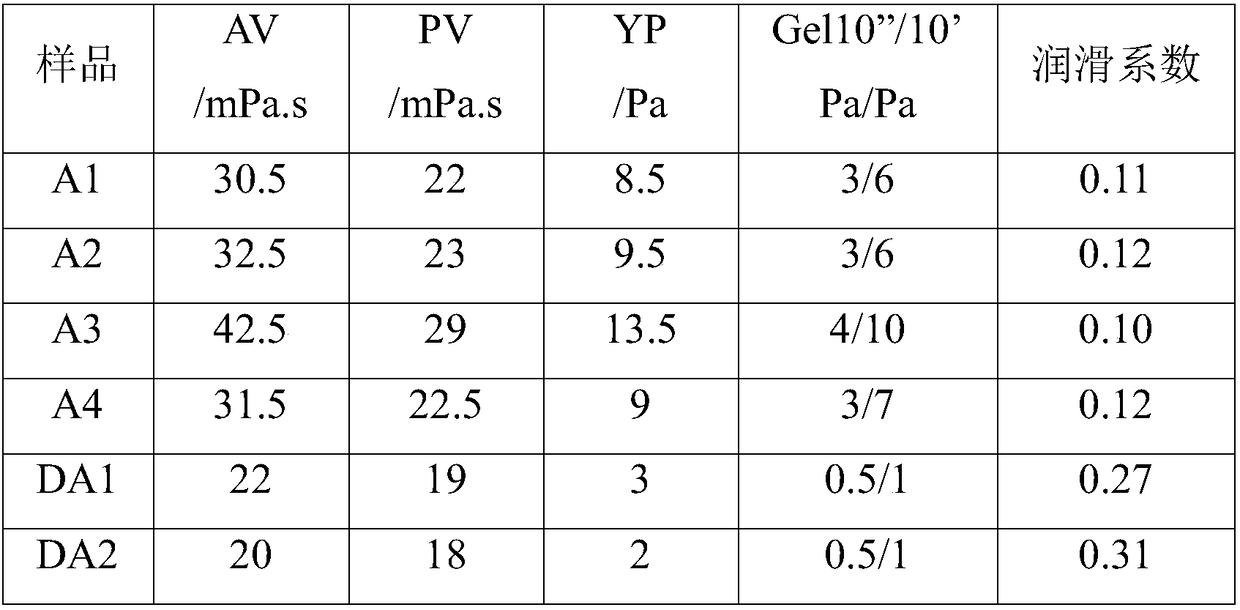High-temperature-resistant tackifying rheology modifier for drilling fluids, and preparation method thereof, and drilling fluid
A drilling fluid and high temperature resistance technology, which is applied in the field of oil field drilling fluid, can solve the problems of insufficient temperature resistance of viscosifiers, achieve excellent thermal stability, improve drilling efficiency, and reduce friction and torque
- Summary
- Abstract
- Description
- Claims
- Application Information
AI Technical Summary
Problems solved by technology
Method used
Image
Examples
Embodiment 1
[0056] Place a 500mL beaker in a constant temperature water bath, add 200g of a 1% weight concentration sodium alginate solution, stir with a shear emulsifying mixer at 1500 rpm, and simultaneously raise the temperature to 40°C. After the temperature rises to the specified value, slowly add 50 g of calcium chloride solution with a concentration of 0.5% by weight to the flask through a peristaltic pump while stirring. The obtained product aqueous solution was centrifuged to separate the solid phase, washed repeatedly with deionized water and ethanol several times, and then vacuum-dried at 60°C for 16 hours to finally obtain powdered calcium alginate microgel. The product calcium alginate microgel was determined as spherical particles with an average particle diameter of 535 nm by transmission electron microscopy (TEM).
Embodiment 2
[0058] Place a 500mL beaker in a constant temperature water bath, add 200g of a 2% weight concentration sodium alginate solution, stir with a shear emulsifying stirrer at 1500 rpm, and simultaneously raise the temperature to 40°C. After the temperature rises to the specified value, slowly add 50 g of calcium chloride solution with a concentration of 0.5% by weight to the flask through a peristaltic pump while stirring. The obtained product aqueous solution was centrifuged to separate the solid phase, washed repeatedly with deionized water and ethanol several times, and then vacuum-dried at 60°C for 16 hours to finally obtain powdered calcium alginate microgel. The product calcium alginate microgel was determined to be spherical particles with an average particle diameter of 458 nm by transmission electron microscopy (TEM).
Embodiment 3
[0060] Place a 500mL beaker in a constant temperature water bath, add 200g of a 4% weight concentration sodium alginate solution, stir with a shear emulsifying mixer at 1500 rpm, and simultaneously raise the temperature to 40°C. After the temperature rises to the specified value, slowly add 50 g of calcium chloride solution with a concentration of 0.5% by weight to the flask through a peristaltic pump while stirring. The obtained product aqueous solution was centrifuged to separate the solid phase, washed repeatedly with deionized water and ethanol several times, and then vacuum-dried at 60°C for 16 hours to finally obtain powdered calcium alginate microgel. The product calcium alginate microgel was determined as spherical particles with an average particle diameter of 286 nm by transmission electron microscopy (TEM).
PUM
| Property | Measurement | Unit |
|---|---|---|
| particle size | aaaaa | aaaaa |
| particle size | aaaaa | aaaaa |
| particle size | aaaaa | aaaaa |
Abstract
Description
Claims
Application Information
 Login to View More
Login to View More - R&D
- Intellectual Property
- Life Sciences
- Materials
- Tech Scout
- Unparalleled Data Quality
- Higher Quality Content
- 60% Fewer Hallucinations
Browse by: Latest US Patents, China's latest patents, Technical Efficacy Thesaurus, Application Domain, Technology Topic, Popular Technical Reports.
© 2025 PatSnap. All rights reserved.Legal|Privacy policy|Modern Slavery Act Transparency Statement|Sitemap|About US| Contact US: help@patsnap.com

